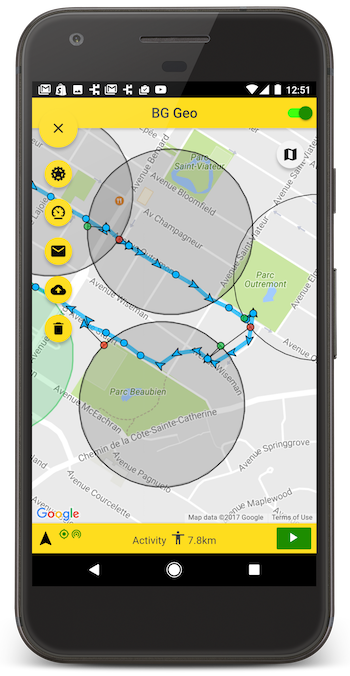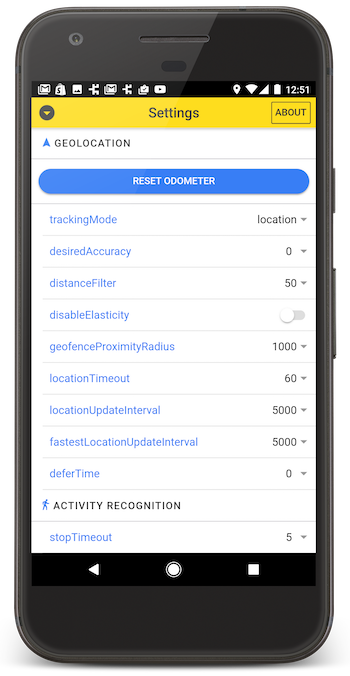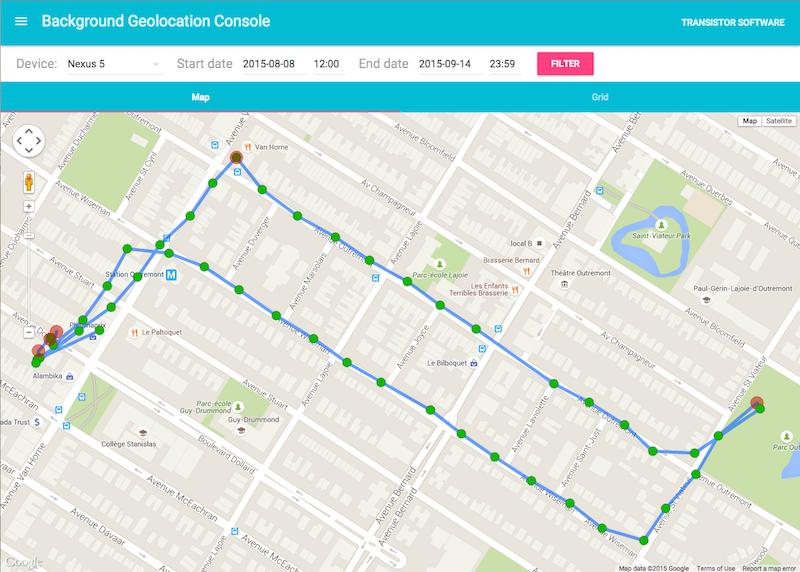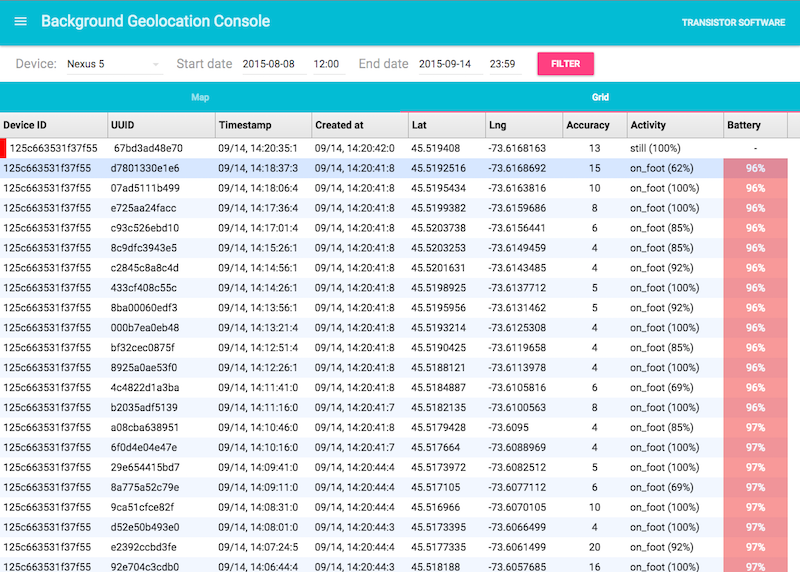
Security News
Weekly Downloads Now Available in npm Package Search Results
Socket's package search now displays weekly downloads for npm packages, helping developers quickly assess popularity and make more informed decisions.
react-native-background-geolocation
Advanced tools
The most sophisticated cross-platform background location-tracking & geofencing module with battery-conscious motion-detection intelligence
 | Now with Expo support |
|---|


The most sophisticated background location-tracking & geofencing module with battery-conscious motion-detection intelligence for iOS and Android.
The plugin's Philosophy of Operation is to use motion-detection APIs (using accelerometer, gyroscope and magnetometer) to detect when the device is moving and stationary.
When the device is detected to be moving, the plugin will automatically start recording a location according to the configured distanceFilter (meters).
When the device is detected be stationary, the plugin will automatically turn off location-services to conserve energy.
Also available for Flutter, Cordova, NativeScript and pure native apps.
[!NOTE] The Android module requires purchasing a license. However, it will work for DEBUG builds. It will not work with RELEASE builds without purchasing a license. This plugin is supported full-time and field-tested daily since 2013.


npx expo install react-native-background-geolocation
yarnyarn add react-native-background-geolocation
npm$ npm install react-native-background-geolocation --save
Login to Customer Dashboard to generate an application key:
www.transistorsoft.com/shop/customers

Add your license-key to android/app/src/main/AndroidManifest.xml:
<manifest xmlns:android="http://schemas.android.com/apk/res/android"
package="com.transistorsoft.backgroundgeolocation.react">
<application
android:name=".MainApplication"
android:allowBackup="true"
android:label="@string/app_name"
android:icon="@mipmap/ic_launcher"
android:theme="@style/AppTheme">
<!-- react-native-background-geolocation licence -->
+ <meta-data android:name="com.transistorsoft.locationmanager.license" android:value="YOUR_LICENCE_KEY_HERE" />
.
.
.
</application>
</manifest>
import BackgroundGeolocation from "react-native-background-geolocation";
For those using Typescript (recommended), you can also import the interfaces:
import BackgroundGeolocation, {
State,
Config,
Location,
LocationError,
Geofence,
GeofenceEvent,
GeofencesChangeEvent,
HeartbeatEvent,
HttpEvent,
MotionActivityEvent,
MotionChangeEvent,
ProviderChangeEvent,
ConnectivityChangeEvent
} from "react-native-background-geolocation";
For more information, see this blog post
There are three main steps to using BackgroundGeolocation
.ready(config) the plugin..start() the plugin.[!WARNING] Do not execute any API method which will require accessing location-services until the
.ready(config)method resolves (Read its API docs), For example:
.getCurrentPosition.watchPosition.start
// NO! .ready() has not resolved.
BackgroundGeolocation.getCurrentPosition(options);
BackgroundGeolocation.start();
BackgroundGeolocation.ready(config).then((state) => {
// YES -- .ready() has now resolved.
BackgroundGeolocation.getCurrentPosition(options);
BackgroundGeolocation.start();
});
// NO! .ready() has not resolved.
BackgroundGeolocation.getCurrentPosition(options);
BackgroundGeolocation.start();
import React from 'react';
import {
Switch,
Text,
View,
} from 'react-native';
import BackgroundGeolocation, {
Location,
Subscription
} from "react-native-background-geolocation";
const HelloWorld = () => {
const [enabled, setEnabled] = React.useState(false);
const [location, setLocation] = React.useState('');
React.useEffect(() => {
/// 1. Subscribe to events.
const onLocation:Subscription = BackgroundGeolocation.onLocation((location) => {
console.log('[onLocation]', location);
setLocation(JSON.stringify(location, null, 2));
})
const onMotionChange:Subscription = BackgroundGeolocation.onMotionChange((event) => {
console.log('[onMotionChange]', event);
});
const onActivityChange:Subscription = BackgroundGeolocation.onActivityChange((event) => {
console.log('[onActivityChange]', event);
})
const onProviderChange:Subscription = BackgroundGeolocation.onProviderChange((event) => {
console.log('[onProviderChange]', event);
})
/// 2. ready the plugin.
BackgroundGeolocation.ready({
// Geolocation Config
desiredAccuracy: BackgroundGeolocation.DESIRED_ACCURACY_HIGH,
distanceFilter: 10,
// Activity Recognition
stopTimeout: 5,
// Application config
debug: true, // <-- enable this hear sounds for background-geolocation life-cycle.
logLevel: BackgroundGeolocation.LOG_LEVEL_VERBOSE,
stopOnTerminate: false, // <-- Allow the background-service to continue tracking when user closes the app.
startOnBoot: true, // <-- Auto start tracking when device is powered-up.
// HTTP / SQLite config
url: 'http://yourserver.com/locations',
batchSync: false, // <-- [Default: false] Set true to sync locations to server in a single HTTP request.
autoSync: true, // <-- [Default: true] Set true to sync each location to server as it arrives.
headers: { // <-- Optional HTTP headers
"X-FOO": "bar"
},
params: { // <-- Optional HTTP params
"auth_token": "maybe_your_server_authenticates_via_token_YES?"
}
}).then((state) => {
setEnabled(state.enabled)
console.log("- BackgroundGeolocation is configured and ready: ", state.enabled);
});
return () => {
// Remove BackgroundGeolocation event-subscribers when the View is removed or refreshed
// during development live-reload. Without this, event-listeners will accumulate with
// each refresh during live-reload.
onLocation.remove();
onMotionChange.remove();
onActivityChange.remove();
onProviderChange.remove();
}
}, []);
/// 3. start / stop BackgroundGeolocation
React.useEffect(() => {
if (enabled) {
BackgroundGeolocation.start();
} else {
BackgroundGeolocation.stop();
setLocation('');
}
}, [enabled]);
return (
<View style={{alignItems:'center'}}>
<Text>Click to enable BackgroundGeolocation</Text>
<Switch value={enabled} onValueChange={setEnabled} />
<Text style={{fontFamily:'monospace', fontSize:12}}>{location}</Text>
</View>
)
}
export default HelloWorld;
import React from 'react';
import {
Switch,
Text,
View,
} from 'react-native';
import BackgroundGeolocation, {
Location,
Subscription
} from "react-native-background-geolocation";
export default class HelloWorld extends React.Component {
subscriptions:Subscription[] = [];
state:any = {};
constructor(props:any) {
super(props);
this.state = {
enabled: false,
location: ''
}
}
componentDidMount() {
/// 1. Subscribe to BackgroundGeolocation events.
this.subscriptions.push(BackgroundGeolocation.onLocation((location) => {
console.log('[onLocation]', location);
this.setState({location: JSON.stringify(location, null, 2)})
}, (error) => {
console.log('[onLocation] ERROR:', error);
}))
this.subscriptions.push(BackgroundGeolocation.onMotionChange((event) => {
console.log('[onMotionChange]', event);
}))
this.subscriptions.push(BackgroundGeolocation.onActivityChange((event) => {
console.log('[onActivityChange]', event);
}))
this.subscriptions.push(BackgroundGeolocation.onProviderChange((event) => {
console.log('[onProviderChange]', event);
}))
/// 2. ready the plugin.
BackgroundGeolocation.ready({
// Geolocation Config
desiredAccuracy: BackgroundGeolocation.DESIRED_ACCURACY_HIGH,
distanceFilter: 10,
// Activity Recognition
stopTimeout: 5,
// Application config
debug: true, // <-- enable this hear sounds for background-geolocation life-cycle.
logLevel: BackgroundGeolocation.LOG_LEVEL_VERBOSE,
stopOnTerminate: false, // <-- Allow the background-service to continue tracking when user closes the app.
startOnBoot: true, // <-- Auto start tracking when device is powered-up.
// HTTP / SQLite config
url: 'http://yourserver.com/locations',
batchSync: false, // <-- [Default: false] Set true to sync locations to server in a single HTTP request.
autoSync: true, // <-- [Default: true] Set true to sync each location to server as it arrives.
headers: { // <-- Optional HTTP headers
"X-FOO": "bar"
},
params: { // <-- Optional HTTP params
"auth_token": "maybe_your_server_authenticates_via_token_YES?"
}
}).then((state) => {
this.setState({enabled: state.enabled});
console.log("- BackgroundGeolocation is configured and ready: ", state.enabled);
})
}
/// When view is destroyed (or refreshed during development live-reload),
/// remove BackgroundGeolocation event subscriptions.
componentWillUnmount() {
this.subscriptions.forEach((subscription) => subscription.remove());
}
onToggleEnabled(value:boolean) {
console.log('[onToggleEnabled]', value);
this.setState({enabled: value})
if (value) {
BackgroundGeolocation.start();
} else {
this.setState({location: ''});
BackgroundGeolocation.stop();
}
}
render() {
return (
<View style={{alignItems:'center'}}>
<Text>Click to enable BackgroundGeolocation</Text>
<Switch value={this.state.enabled} onValueChange={this.onToggleEnabled.bind(this)} />
<Text style={{fontFamily:'monospace', fontSize:12}}>{this.state.location}</Text>
</View>
)
}
}
The BackgroundGeolocation Javascript API supports Promises for nearly every method (the exceptions are #watchPosition and adding event-listeners via #onXXX method (eg: onLocation). For more information, see the API Documentation
BackgroundGeolocation.ready({
desiredAccuracy: BackgroundGeolocation.DESIRED_ACCURACY_HIGH,
distanceFilter: 50
}).then(state => {
console.log('- BackgroundGeolocation is ready: ', state);
}).catch(error => {
console.warn('- BackgroundGeolocation error: ', error);
});
// Or use await in an async function
try {
const state = await BackgroundGeolocation.ready({
desiredAccuracy: BackgroundGeolocation.DESIRED_ACCURACY_HIGH,
distanceFilter: 50
})
console.log('- BackgroundGeolocation is ready: ', state);
} catch (error) {
console.warn('- BackgroundGeolocation error: ', error);
}
A fully-featured Demo App is available in its own public repo. After first cloning that repo, follow the installation instructions in the README there. This demo-app includes a settings-screen allowing you to quickly experiment with all the different settings available for each platform.


A simple Node-based web-application with SQLite database is available for field-testing and performance analysis. If you're familiar with Node, you can have this server up-and-running in about one minute.


The MIT License (MIT)
Copyright (c) 2018 Chris Scott, Transistor Software
Permission is hereby granted, free of charge, to any person obtaining a copy of this software and associated documentation files (the "Software"), to deal in the Software without restriction, including without limitation the rights to use, copy, modify, merge, publish, distribute, sublicense, and/or sell copies of the Software, and to permit persons to whom the Software is furnished to do so, subject to the following conditions:
The above copyright notice and this permission notice shall be included in all copies or substantial portions of the Software.
THE SOFTWARE IS PROVIDED "AS IS", WITHOUT WARRANTY OF ANY KIND, EXPRESS OR IMPLIED, INCLUDING BUT NOT LIMITED TO THE WARRANTIES OF MERCHANTABILITY, FITNESS FOR A PARTICULAR PURPOSE AND NONINFRINGEMENT. IN NO EVENT SHALL THE AUTHORS OR COPYRIGHT HOLDERS BE LIABLE FOR ANY CLAIM, DAMAGES OR OTHER LIABILITY, WHETHER IN AN ACTION OF CONTRACT, TORT OR OTHERWISE, ARISING FROM, OUT OF OR IN CONNECTION WITH THE SOFTWARE OR THE USE OR OTHER DEALINGS IN THE SOFTWARE.
4.17.6 — 2024-11=12
150TSLocationManagerActivity (responsible for showing location permission / authorization dialogs). Minimizing the app with an active permission dialog would cause the app's MainActivity to terminate on some devices.FAQs
The most sophisticated cross-platform background location-tracking & geofencing module with battery-conscious motion-detection intelligence
The npm package react-native-background-geolocation receives a total of 10,548 weekly downloads. As such, react-native-background-geolocation popularity was classified as popular.
We found that react-native-background-geolocation demonstrated a healthy version release cadence and project activity because the last version was released less than a year ago. It has 0 open source maintainers collaborating on the project.
Did you know?

Socket for GitHub automatically highlights issues in each pull request and monitors the health of all your open source dependencies. Discover the contents of your packages and block harmful activity before you install or update your dependencies.

Security News
Socket's package search now displays weekly downloads for npm packages, helping developers quickly assess popularity and make more informed decisions.

Security News
A Stanford study reveals 9.5% of engineers contribute almost nothing, costing tech $90B annually, with remote work fueling the rise of "ghost engineers."

Research
Security News
Socket’s threat research team has detected six malicious npm packages typosquatting popular libraries to insert SSH backdoors.